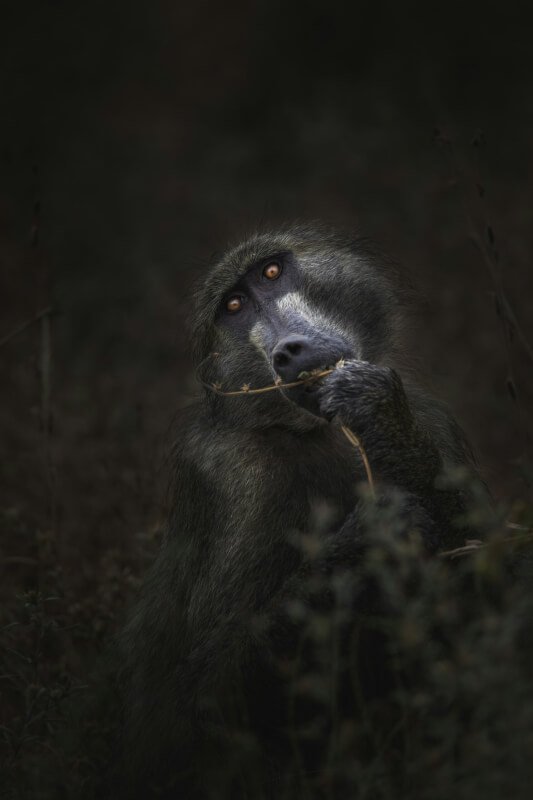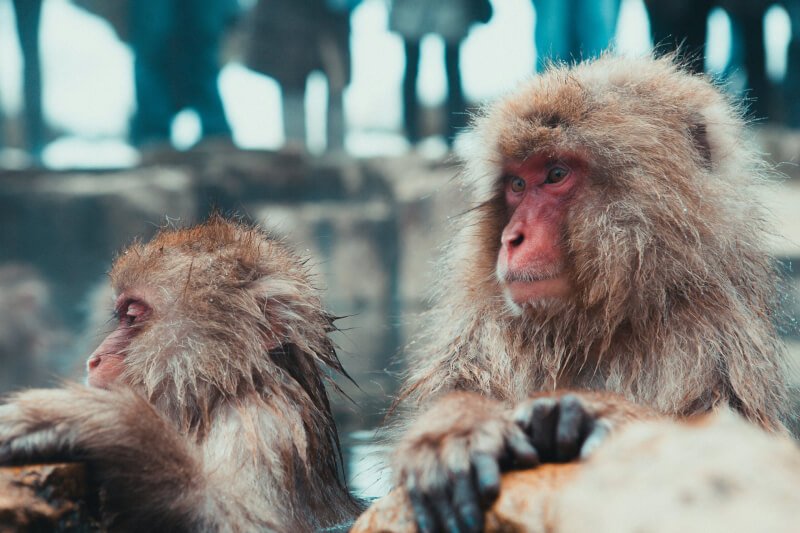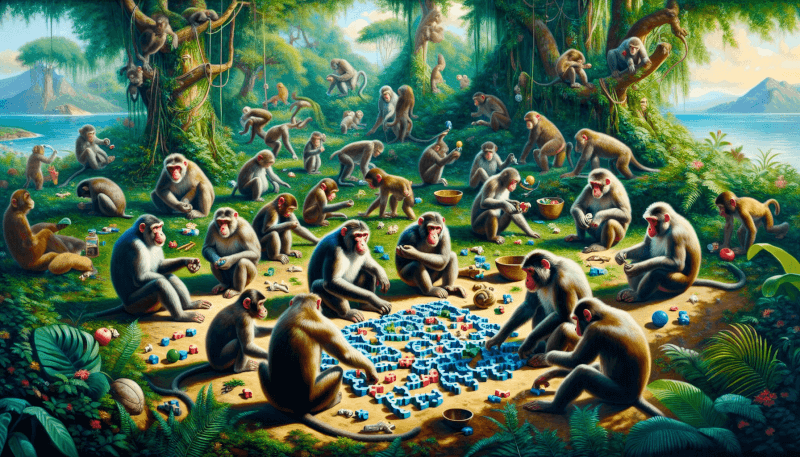If you’ve ever observed primates in the wild or at a zoo, you may have noticed how play and social interaction play a vital role in their daily lives. But have you ever wondered how exactly these behaviors are promoted among these intelligent creatures? In this article, we’ll explore some effective strategies for encouraging play and social interaction among primates, highlighting the importance of these activities for their overall well-being. From environmental enrichment to group dynamics, we’ll uncover the secrets to unlocking the playful spirits within these fascinating creatures. So, grab a banana and get ready to discover the key to promoting play and social interaction among primates like never before!

Creating a Stimulating Environment
Providing Enrichment Structures
To promote play and social interaction among primates, it is important to provide them with enrichment structures. These can include items such as climbing structures, hammocks, and swings. These structures not only provide opportunities for physical exercise and mental stimulation but also encourage social interaction among the primates. By having different levels and spaces within the enclosure, primates can engage in playful chasing, climbing, and even resting together.
Offering Novel Objects and Toys
Another way to encourage play and social interaction among primates is by offering them novel objects and toys. Primates are naturally curious creatures, and providing them with new objects to explore can spark their interest and encourage play. These toys can include puzzle feeders, soft plush toys, or durable balls. The presence of these objects in their environment can also enhance their cognitive abilities and problem-solving skills.
Using Natural Elements for Play
In addition to man-made structures and toys, utilizing natural elements within the enclosure can further stimulate play and social interaction among primates. This can include adding branches, ropes, and rocks for climbing, as well as sand or water features for sensory play. These natural elements provide opportunities for the primates to engage in different types of play, such as swinging from branches or splashing in the water, while also mimicking their natural habitat.
Implementing Playful Feeding Methods
Food Puzzle Toys
One effective way to promote play and social interaction during feeding time is by using food puzzle toys. These toys are designed to challenge the primates mentally and physically as they work to retrieve their food. By dispersing food in various compartments or using puzzles that require problem-solving skills, the primates are encouraged to engage in playful behaviors and interact with each other. This also helps to stimulate their natural foraging instincts and keeps them mentally stimulated.
Scatter Feeding Techniques
Scatter feeding techniques involve scattering food or treats throughout the enclosure, encouraging the primates to actively search for their food. This not only provides a fun and engaging feeding experience but also promotes social interaction as the primates compete or cooperate to find the scattered food. It encourages them to explore their surroundings and interact with one another in a playful and natural way.
Feeding Time as a Play Activity
Feeding time can also be utilized as a play activity to encourage social interaction. Instead of simply placing the food in a bowl, caretakers can incorporate interactive feeders or training exercises during mealtime. For example, using a target stick or a clicker to guide the primates to perform tricks or behaviors before receiving their food. This not only strengthens the bond between the caretakers and the primates but also promotes mental stimulation and social interaction.
Encouraging Group Activities
Organizing Group Play Sessions
Group play sessions can be a great way to promote play and social interaction among primates. By allowing multiple primates to engage in play simultaneously, they have the opportunity to interact, learn from each other, and develop social skills. Caretakers can organize structured play sessions that involve group games, obstacle courses, or even supervised wrestling matches. These activities encourage positive social interactions and help build group cohesion.
Facilitating Cooperative Feeding
Cooperative feeding is another effective way to encourage group activities among primates. This can be done by providing a large food item, such as a pile of fruits or vegetables, which requires the primates to work together to obtain their meal. This not only promotes social interaction but also encourages problem-solving skills and cooperation within the group. By fostering a cooperative feeding environment, primates learn to rely on and support each other, enhancing their social bonds.
Promoting Group Exploration
Group exploration activities can also be implemented to encourage social interaction among primates. This can involve introducing new elements or objects within the enclosure that provoke curiosity and encourage the primates to explore together. Caretakers can strategically place novel objects, hiding spots, or food sources throughout the enclosure to stimulate group exploration and foster social interactions. This promotes a sense of cooperation and shared experiences among the primates.
Providing Socialization Opportunities
Introducing New Primates Gradually
When introducing new primates into a group, it is essential to do so gradually and with caution. Caretakers should follow a careful introduction process that includes visual introductions first, where the primates can see and smell each other without direct contact. This helps to reduce stress and aggression that might occur with immediate introductions. Once the primates have become familiar with each other’s presence, gradual physical introductions can be made under close supervision. This slow and controlled approach ensures a smoother integration process and promotes positive social interactions.
Allowing Social Interactions during Feeding
Feeding time provides a valuable opportunity for social interaction among primates. Caretakers can take advantage of this by allowing the primates to eat together in a communal setting. This not only encourages the sharing of food but also promotes positive social behaviors, such as grooming or playing. By providing ample space and resources during feeding time, primates can establish social hierarchies, bond with one another, and engage in playful interactions.
Rotating Individuals within Groups
To further promote socialization opportunities, caretakers can rotate individuals within groups. This can be done by periodically transferring primates between enclosures or introducing new members to existing groups. By changing the composition of the group, primates are exposed to different social dynamics, fostering the development of diverse social skills and encouraging social interaction. It also prevents the formation of exclusive cliques or dominance hierarchies within the group.

Facilitating Playful Challenges
Setting Up Obstacle Courses
Obstacle courses are an effective way to stimulate play and challenge primates physically and mentally. Caretakers can design obstacle courses that incorporate various elements, such as tunnels, platforms, and swings. These courses encourage the primates to navigate through the different challenges and obstacles, promoting physical exercise and problem-solving skills. Group activities can be organized where multiple primates tackle the obstacle course together, fostering cooperation and playful competition.
Creating Climbing Structures
Primates are natural climbers, and providing them with climbing structures can facilitate playful challenges. These structures can include vertical platforms, ropes, and trees. By incorporating different levels and textures within the climbing structures, primates are encouraged to explore and interact with their environment. It also provides them with opportunities for physical exercise, social interaction, and the development of their climbing abilities.
Introducing Problem-Solving Games
Problem-solving games are an engaging way to stimulate play and mental agility among primates. Caretakers can design games that require the primates to use their problem-solving skills to access treats or rewards. This can include puzzles that have to be manipulated, boxes that need to be opened, or hidden food that needs to be discovered. By engaging in these games, primates are stimulated intellectually, promoting play and encouraging social interaction as they observe and learn from each other’s strategies.
Implementing Positive Reinforcement
Using Treats or Rewards
Positive reinforcement plays a crucial role in promoting play and social interaction among primates. Using treats or rewards during training or play activities can motivate and reinforce desired behaviors. Caretakers can use high-value treats such as fruits or nuts to reward playful and social behaviors, such as gentle interactions or cooperative play. The presence of treats helps to create positive associations with play and encourages the primates to engage in more playful and social interactions.
Applauding Playful Behaviors
Just as humans enjoy receiving praise and recognition, primates also appreciate positive feedback. Caretakers can applaud and verbally express approval when primates engage in playful behaviors or positive social interactions. This positive reinforcement encourages the repetition of those behaviors and reinforces the bond between caretakers and primates. By providing positive feedback, caretakers actively encourage and promote play and social interaction among the primates.
Employing Clicker Training Techniques
Clicker training techniques can be effective in promoting play and social interaction among primates. By using a clicker as a marker for desired behaviors, caretakers can train primates to engage in specific playful or social behaviors and reward them accordingly. The primates learn to associate the clicker sound with positive reinforcement and are motivated to repeat the behaviors that earned them a reward. Clicker training promotes mental stimulation, enhances the bond between caretakers and primates, and encourages playful and social interactions.

Balancing Free Play and Structured Activities
Allowing Unstructured Playtime
Unstructured playtime is essential for primates to express natural behaviors, bond with one another, and engage in creative and imaginative play. Caretakers should provide regular periods of free play where the primates have the freedom to interact, explore, and play without intervention. This unstructured playtime allows the primates to establish their own social dynamics, engage in self-directed play, and actively participate in their own enrichment.
Creating Playtime Schedules
While unstructured playtime is important, structured activities and playtime schedules can also promote play and social interaction among primates. Caretakers can plan specific play sessions or activities throughout the day, ensuring that the primates have opportunities to engage in different types of play and socialize with others. These scheduled playtimes provide a balance between free play and structured activities, ensuring that the primates receive a well-rounded enrichment experience.
Combining Play with Training Sessions
Integrating play with training sessions can yield multiple benefits for the primates. Caretakers can incorporate play elements and toys within training sessions, making them more enjoyable and engaging for the primates. This not only promotes mental stimulation but also encourages social interaction as the primates learn and perform behaviors together. By combining play with training sessions, caretakers can strengthen the bond with the primates, enhance their learning abilities, and encourage playful and social behaviors.
Creating Safe and Secure Environments
Ensuring Adequate Enclosure Design
Creating a safe and secure environment is crucial for promoting play and social interaction among primates. Enclosures should be designed to provide ample space for movement, play, and socialization. It should also have secure fencing, suitable climbing structures, and hiding spots. Caretakers should regularly inspect enclosures to ensure there are no sharp edges, loose wires, or potential hazards that could harm the primates during play. By providing a well-designed and secure enclosure, caretakers can create an environment that fosters play and encourages positive social interactions.
Monitoring Interactions for Safety
While promoting play and social interaction is essential, it is equally important for caretakers to monitor these interactions for safety. Caretakers should observe the primates closely during playtime, ensuring that there is no aggressive or harmful behavior. Interventions may be required if any conflicts or potential dangers arise. Regular monitoring allows caretakers to intervene when necessary, preventing injuries and promoting a safe and positive play environment.
Implementing Regular Health Checks
Regular health checks are essential to ensure the well-being of the primates. Routine examinations, vaccinations, and parasite control should be implemented to maintain the health of the primates. Additionally, thorough health checks should be conducted before introducing new primates into a group to prevent the spread of diseases. By implementing regular health checks, caretakers can ensure that the primates are in optimal health to engage in play and social interactions.

Observing and Understanding Primate Behavior
Identifying Playful Gestures and Postures
Observing and understanding primate behavior is crucial in promoting play and social interaction. Caretakers should be able to recognize playful gestures and postures displayed by the primates. Playful behaviors can include chasing, rolling, or jumping, while play postures may include a relaxed and open body posture. Identifying these behaviors allows caretakers to gauge the level of playfulness and assess the overall well-being of the primates.
Recognizing Social Hierarchy
Understanding the social hierarchy within primate groups is essential for promoting positive social interactions. Caretakers should be able to recognize dominant and submissive behaviors displayed by the primates. This knowledge helps caretakers intervene when necessary to prevent conflicts or ensure fair play within the group. By recognizing and respecting the social hierarchy, caretakers can create an environment that fosters positive social interactions and reduces stress among the primates.
Understanding Communication Signals
Primates communicate through a variety of signals, including facial expressions, vocalizations, and body language. Caretakers should familiarize themselves with these communication signals to better understand the primates’ needs and intentions. By understanding their communication cues, caretakers can appropriately respond to their emotions and encourage positive social interactions. This understanding also helps to prevent misinterpretations or conflicts during play and socialization.
Promoting Personal Bonds between Caretakers and Primates
Engaging in Gentle Physical Contact
Developing a personal bond between caretakers and primates is essential in promoting play and social interaction. Caretakers can engage in gentle physical contact, such as grooming or gentle touches, to establish trust and companionship with the primates. This physical interaction not only enhances the bond between caretakers and primates but also promotes a sense of security and comfort, encouraging the primates to engage in more playful and social behaviors.
Spending Quality Time Together
Spending quality time together is crucial for developing personal bonds with primates. Caretakers should allocate dedicated time for one-on-one interactions with the primates. This can include activities such as grooming, training, or simply sitting and observing their behaviors. This quality time allows caretakers to understand the individual personalities and preferences of the primates, strengthening the bond and promoting positive social interactions.
Building Trust through Positive Interactions
Building trust is essential for promoting play and social interaction among primates. Caretakers can establish trust through positive interactions, such as offering treats, engaging in gentle play, or providing positive reinforcement. By consistently providing positive experiences and interactions, caretakers build trust with the primates, ensuring a safe and comfortable environment for them to engage in playful and social behaviors.
In conclusion, promoting play and social interaction among primates requires a comprehensive approach that encompasses providing a stimulating environment, implementing playful feeding methods, encouraging group activities, facilitating socialization opportunities, facilitating playful challenges, implementing positive reinforcement, balancing free play and structured activities, creating safe and secure environments, observing and understanding primate behavior, and promoting personal bonds between caretakers and primates. By implementing these strategies, caretakers can provide a nurturing and enriching environment that supports the physical and social well-being of primates.



